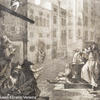5: Excerpt, Mitchell Dunier’s "Ghetto," 2016, and image, Giovanni Andrea Dalle Piane’s “The New Moon on Taking Leave of Shabbat: Blessing the Moon,” mid-1700’s.
Mitchell Dunier’s 2016 book explores the history and concept of the ghetto, especially in terms of urban, African American neighborhoods in the United States in the twentieth century.
Art historians believe that the artist Dalle Piane may have based this engraving on the Jewish ghetto in Reggio Emilia or the one in Venice, but it is an unusual example of art depicting Jewish life in Italy before the nineteenth century.
Suggested Activity: Before beginning to study the play, ask students what the word “ghetto” means. Ask them where they think it comes from. Have them read the excerpt of Dunier’s book, and show them the image. Once they’ve read the play, come back to this excerpt and ask them how the modern history of the term ghetto might change the way they think about Shylock and other Jews in The Merchant of Venice. Then, show them Dalle Piane’s engraving, and ask them whether the scene depicted looks like a ghetto—why or why not? How do the costumes and gestures of the Jewish people represented here change the way they think about the visual appearance of Shylock?
Sources: Mitchell Dunier, Ghetto: The Invention of a Place, the History of an Idea (New York: Farrar, Straus and Giroux, 2016), ix-x.
Giovanni Andrea Dalle Piane, The New Moon on Taking Leave of Shabbat: Blessing the Moon, c. eighteenth century, in Venice, the Jews, and Europe, 1516-2016 (Venezia: Marsilio, 2016), 255.
Venetian-Ghetto-2_edit.jpg
 Download image (449.75 KB)
Download image (449.75 KB)

